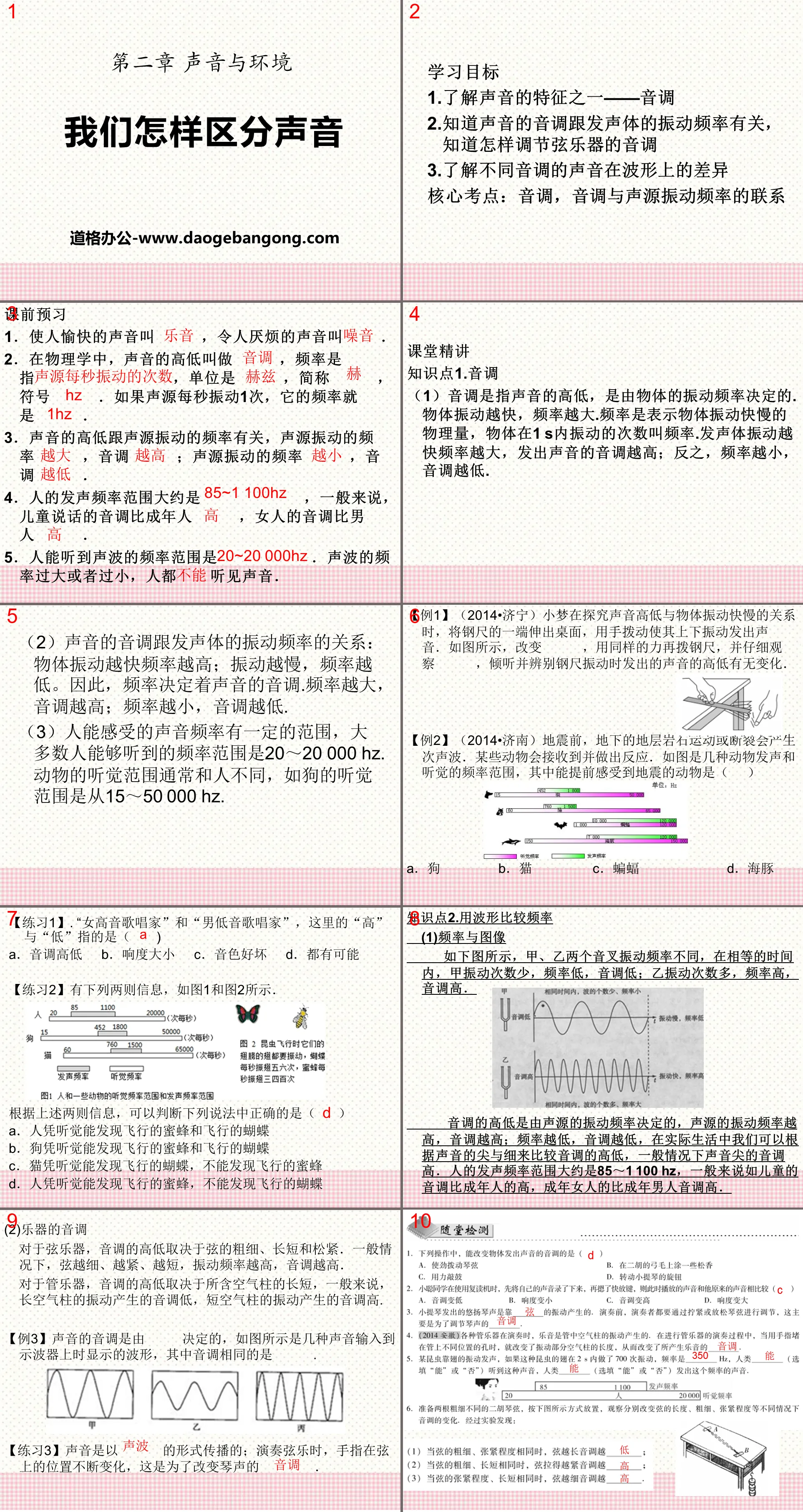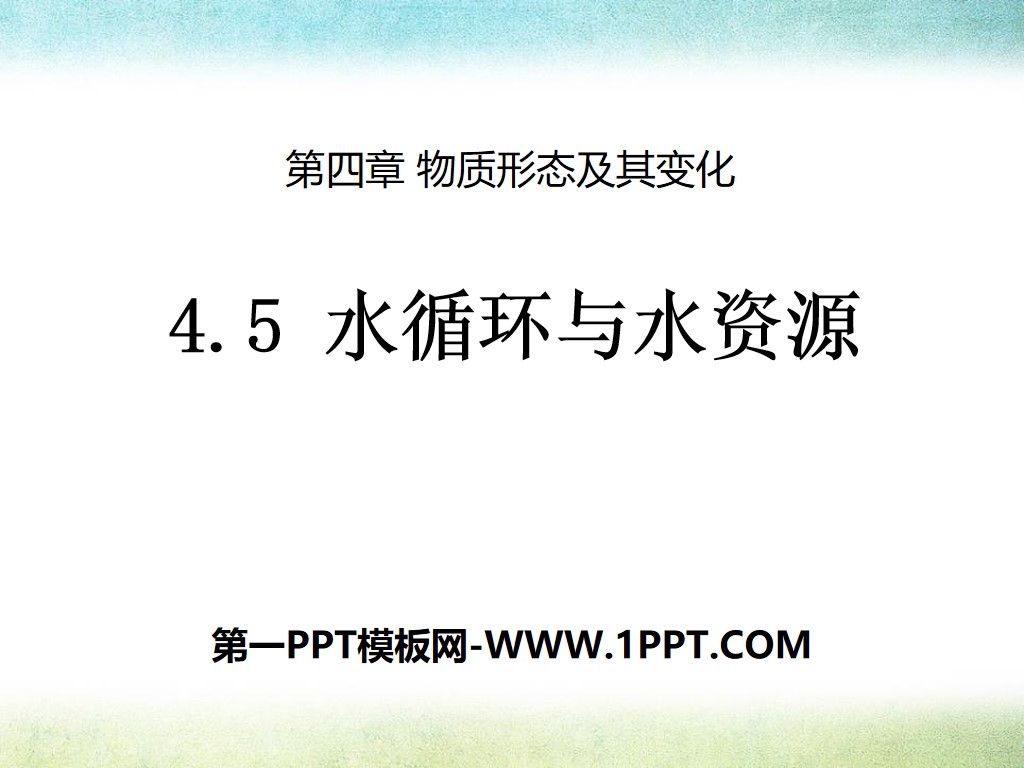
| Category | Format | Size |
|---|---|---|
| Guangdong and Shanghai version of eighth grade physics volume one | pptx | 6 MB |
Description
"How Do We Distinguish Sounds" Sound and Environment PPT Courseware 2
learning target
1. Understand one of the characteristics of sound - pitch
2. Know that the pitch of sound is related to the vibration frequency of the sound-emitting body, and know how to adjust the pitch of stringed instruments
3. Understand the differences in waveforms of sounds with different tones
Core test point: pitch, the relationship between pitch and vibration frequency of the sound source
Preview before class
1. Pleasant sounds are called _______, and annoying sounds are called _______.
2. In physics, the pitch of sound is called _______, the frequency refers to __________, the unit is _______, abbreviated as _______, and the symbol is _______. If a sound source vibrates once per second, its frequency is _______.
3. The level of the sound is related to the frequency of the vibration of the sound source. The frequency of the vibration of the sound source is _______, and the pitch is _______; the frequency of the vibration of the sound source is _______, and the pitch is _______.
4. The frequency range of human vocalizations is approximately _______. Generally speaking, children speak in a _______ tone than adults, and women speak in a _______ tone than men.
5. The frequency range that humans can hear sound waves is _______. If the frequency of the sound wave is too high or too low, people will _______ hear the sound.
Lectures in class
Knowledge point 1. Tone
(1) Pitch refers to the pitch of the sound, which is determined by the vibration frequency of the object. The faster the object vibrates, the greater the frequency. Frequency is a physical quantity that indicates how fast an object vibrates. The number of times an object vibrates in 1 s is called frequency. Sound emitter The faster the vibration, the higher the frequency, and the higher the pitch of the sound; conversely, the smaller the frequency, the lower the pitch.
(2) The relationship between the pitch of the sound and the vibration frequency of the sound-emitting body: the faster the object vibrates, the higher the frequency; the slower the vibration, the lower the frequency. Therefore, frequency determines the pitch of a sound. The higher the frequency, the higher the pitch; the lower the frequency, the lower the pitch.
(3) There is a certain range of sound frequencies that people can feel. The frequency range that most people can hear is 20 to 20 000 Hz. The hearing range of animals is usually different from that of people. For example, the hearing range of dogs is from 15 to 50 000 Hz. Hz.
[Exercise 1]. "Soprano singer" and "bass singer", the "high" and "low" here refer to ()
A. Pitch pitch B. Loudness C. The quality of the timbre D. It's possible
[Exercise 2] There are the following two pieces of information, as shown in Figure 1 and Figure 2.
Based on the above two pieces of information, you can determine which of the following statements is correct ( )
A. Humans can detect flying bees and flying butterflies by hearing
B. Dogs can detect flying bees and flying butterflies based on their hearing
C. Cats can detect flying butterflies based on their hearing, but cannot detect flying bees
D. People can detect flying bees by hearing, but they cannot detect flying butterflies.
Knowledge point 2. Use waveforms to compare frequencies
(1) Frequency and image
As shown in the figure below, two tuning forks A and B vibrate at different frequencies. In the same period of time, A vibrates less times, has a lower frequency, and has a lower pitch; B vibrates more times, has a higher frequency, and has a higher pitch.
The pitch is determined by the vibration frequency of the sound source. The higher the vibration frequency of the sound source, the higher the pitch; the lower the frequency, the lower the pitch. In real life, we can compare the pitch based on the sharpness and thinness of the sound. , Generally speaking, the pitch of a sharp sound is high. The frequency range of human vocalization is about 85 to 1100 Hz. Generally speaking, children's pitch is higher than that of adults, and adult women's pitch is higher than that of adult men.
(2)The tone of the musical instrument
For stringed instruments, the pitch depends on the thickness, length and tightness of the strings. Generally speaking, the thinner, tighter, and shorter the string, the higher the vibration frequency and the higher the pitch.
For wind instruments, the pitch depends on the length of the air column contained. Generally speaking, the vibration of a long air column produces a low pitch, and the vibration of a short air column produces a high pitch.
[Example 3] The pitch of a sound is determined by _______. As shown in the figure is the waveform displayed when several sounds are input to an oscilloscope. The one with the same pitch is _______.
[Exercise 3] Sound is transmitted in the form of _______; when playing strings, the position of the fingers on the strings is constantly changing, in order to change the _______ of the sound.
Keywords: Sound and environment teaching courseware, how do we distinguish sound teaching courseware, Guangdong and Shanghai version eighth grade physics PPT courseware download, eighth grade physics slide courseware download, sound and environment PPT courseware download, how do we distinguish sound PPT courseware download, .PPT format;
For more information about the PPT courseware "Sound and Environment How Do We Distinguish Sound", please click the Sound and Environment ppt How Do We Distinguish Sound ppt tag.
"How do we distinguish sounds (continued)" Sound and Environment PPT Courseware 2:
"How do we distinguish sounds (continued)" Sound and Environment PPT Courseware 2 Teaching Objectives 1. Know what loudness and timbre are. Know the factors that determine loudness. Understand the units of loudness. 2. Application of timbre. 3. Understand how sounds of different loudness and timbre behave on waves..
"How do we distinguish sounds (continued)" Sound and environment PPT courseware:
"How do we distinguish sounds (continued)" PPT courseware on sound and environment 1. Loudness of sounds Sounds are not only high and low, but also strong and weak. In physics, the intensity of sound perceived by the human ear is called loudness. Loudness is commonly known as volume or volume. Activity 1: Explore...
"How do we distinguish sounds" Sound and Environment PPT courseware:
"How Do We Distinguish Sounds" Sound and Environment PPT Courseware Teaching Objectives 1. Know the pitch of a sound, and know the factors that determine the pitch. Understand the differences in waveforms of sounds of different pitches. 2. Understand the factors that affect the pitch of stringed instruments. three..
File Info
Update Time: 2024-06-27
This template belongs to Physics courseware Guangdong and Shanghai version of eighth grade physics volume one industry PPT template
"How Do We Distinguish Sounds" Sound and Environment PPT Courseware 2 Simple campus recruitment activity planning plan summary enterprise and institution recruitment publicity lecture PPT template is a general PPT template for business post competition provided by the manuscript PPT, simple campus recruitment activity planning plan summary enterprise and institution recruitment promotion Lecture PPT template, you can edit and modify the text and pictures in the source file by downloading the source file. If you want more exquisite business PPT templates, you can come to grid resource. Doug resource PPT, massive PPT template slide material download, we only make high-quality PPT templates!
Tips: If you open the template and feel that it is not suitable for all your needs, you can search for related content "How Do We Distinguish Sounds" Sound and Environment PPT Courseware 2 is enough.
How to use the Windows system template
Directly decompress the file and use it with office or wps
How to use the Mac system template
Directly decompress the file and use it Office or wps can be used
Related reading
For more detailed PPT-related tutorials and font tutorials, you can view: Click to see
How to create a high-quality technological sense PPT? 4 ways to share the bottom of the box
Notice
Do not download in WeChat, Zhihu, QQ, built-in browsers, please use mobile browsers to download! If you are a mobile phone user, please download it on your computer!
1. The manuscript PPT is only for study and reference, please delete it 24 hours after downloading.
2. If the resource involves your legitimate rights and interests, delete it immediately.
3. Contact information: service@daogebangong.com
"How Do We Distinguish Sounds" Sound and Environment PPT Courseware 2, due to usage restrictions, it is only for personal study and reference use. For commercial use, please go to the relevant official website for authorization.
(Personal non-commercial use refers to the use of this font to complete the display of personal works, including but not limited to the design of personal papers, resumes, etc.)
Preview



















